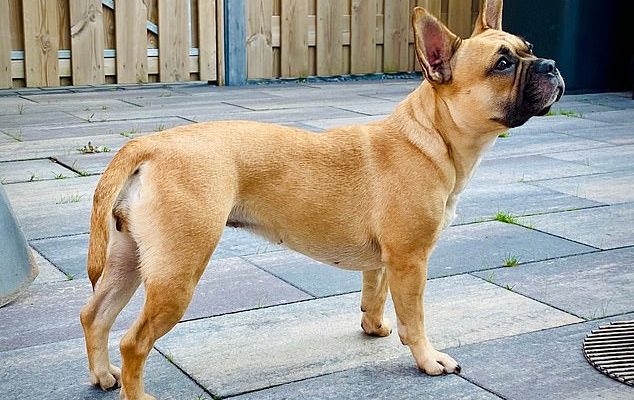The French bulldog is the most popular purebred dog breed in both the US and UK, with its big head, little body, and smushy face inspiring throngs of adoring fans.
But more than a century of breeding for its unique features has left the beloved pet with a host of physical problems – and an average lifespan of 4.5 years.
A new generation of breeders aims to change things for the French bulldog, and the end result may be a new look for the breed – with features like a longer snout to mitigate some of its well-known health problems.
Lily is the first dog that was bred by Hawbucks Franse Bulldog Kennel, a kennel whose owner is trying to breed a healthier Frenchie. Lily still looks like a French bulldog, but she has a longer tail, back, and legs than are often seen in the breed.
Some scientists argue, though, that there are not enough traits in the Frenchie gene pool to bring about these necessary changes.
They told DailyMail.com it may be necessary to breed Frenchies with other dogs to achieve the desired result.
At the same time, experts said this may require the public to rethink what a French bulldog is, because a healthier version of it will probably look a little different than the dog we have been taught to expect.
The French bulldog has big eyes and a flat face, with proportions that trigger the same nurturing and protective instincts in the human brain as a baby does, scientists have said.
They also have a short body – as measured from nose to tail.
Due to their exaggerated body shape, Frenchies frequently experience breathing difficulties, spinal problems, and heat stroke.
Their short spine means they can’t even lick their own rear end; their wrinkly face makes them prone to skin problems; and their narrow hips often require them to give birth via C-section.
And perhaps the most well studied part of a French bulldog anatomy: brachycephaly.
‘Brachycephaly’ means a short skull – in the case of the Frenchie and other flat-faced similar dogs like the pug, English bulldog, and boxer, it means a short snout.
The problem for the French bulldog is that its short, narrow airways have way too much soft tissue in them, professor Erik Olstad told DailyMail.com.
All that soft palate and other tissue in such a short snout is like ‘a four-bedroom house moved into a one-bedroom apartment,’ he said.
Overstuffed airways cause the breed’s characteristic snoring – a trait that the American Kennel Club highlights as one of the its cute features.
‘Whether it’s annoying, amusing, or oddly comforting depends on your tolerance and sense of humor,’ according to the AKC.
Its labored and noisy breathing has real consequences, though.
Olstad is an assistant professor of veterinary medicine at the University of California, Davis. He has seen more than his fair share of French bulldogs die an agonizing death from heat stroke and hyperthermia in the southern California climate where he used to live, he said.
The breed’s breathing problems leave it unable to adequately cool itself, making exercise dangerous under normal conditions, let alone extreme heat.
‘It was just soul wrenching,’ he said. ‘It makes you go, ‘What the hell is this?”
Olstad is no Frenchie hater, though – in fact the opposite is true. He describes them as ‘so damn cute.’

‘When I see a French bulldog, that’s like a cartoon character in my exam room bouncing around,’ he said. ‘I feel the same feelings everyone else does. I’m like: ‘Look at this frigging cute dog, I love it.”
In the Netherlands, Chantal Wageveld-van Kruining is working on a new variety of Frenchie: the Hawbucks French bulldog.
Wageveld-van Kruining fell in love with French bulldogs after she adopted her first one, but spinal problems meant she had to euthanize the beloved dog.
As with many purebred dogs, consumers often simply accept breed-specific health problems – hip dysplasia in German shepherds, cancer in golden retrievers, and so on.
‘Seeing the suffering being completely normalized by the public made me think that we should strive for a change of perspective of what we think of as ‘normal,’ Wageveld-van Kruining told DailyMail.com.
‘It is not normal when a dog breathes with sounds. Or it is not normal a dog can not deliver her puppies naturally due to the body shape or lack of oxygen. Or a dog that can not reach it’s own genitals for grooming because it is so short and heavy built,’ she added.
‘People laugh about these things, but it would serve them well to be in the position themselves where their body withholds them from doing their normal things. The dog’s health and wellbeing should be the priority, not what we as humans find ‘cute’.’
Motivated by a desire to breed a healthier Frenchie, she set out to breed a dog that doesn’t have these health problems – even if it doesn’t necessarily conform to the breed standard of what it should look like.
This means a longer snout and spine, as well as a tail.
And her dog Lily is proof that this is possible.
Lily may not satisfy the dog show crowd, as she does not exhibit extreme French bulldog conformation, but according to genetic testing that Wageveld-van Kruining had done, this dog is 100 percent Frenchie.

Lily is a Hawbucks French bulldog, a variety that is meant to lack the health problems common to other Frenchies
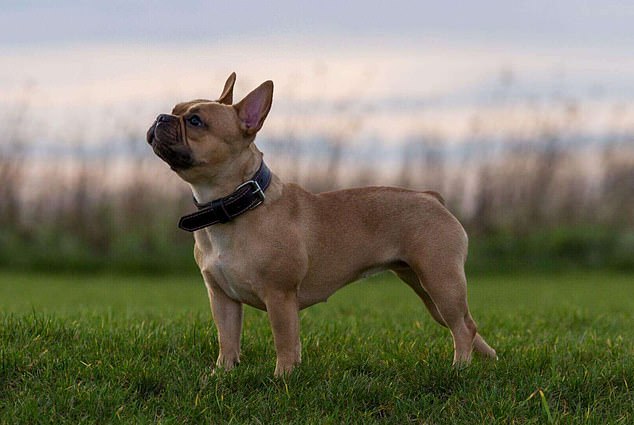
Lily’s mother Yara has more of a typical French bulldog shape, but her snout is longer than average
She is what Wageveld-van Kruining calls a Hawbucks French bulldog, the result of careful breeding to get rid of the harmful French bulldog characteristics – features that experts like Dan O’Neill call ‘extreme conformation.’
O’Neill is an associate professor of companion animal epidemiology at the Royal Veterinary College in London.
‘This dog would certainly fit the bill as a French bulldog that has moved towards improved innate health but that still looks recognizably French bulldog,’ O’Neill said of Lily.
‘The head shape and conformation here strongly suggest that much of this dog’s lineage was the current typical French bulldogs that we are used to,’ he added. ‘But the body is much more moderate; longer back, long tail, longer legs.’
And he would know. O’Neill is part of the Legal Advisory Group on Extreme Conformation in Dogs, a group that is working to develop legal standards for ethical dog breeding.
The group is not just focused on Frenchies, but on all dog breeds for which the breed standard encourages extreme conformation: English bulldogs, pugs, and Cavalier King Charles spaniels, just to name a few.
Others are with them, too.
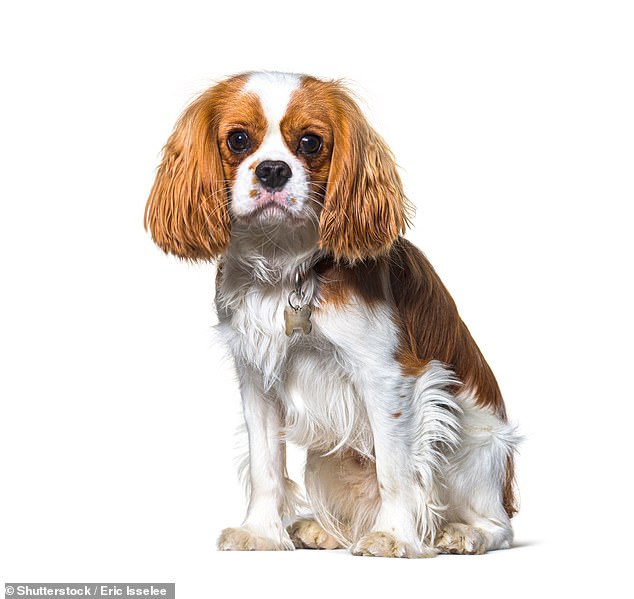
The cavalier King Charles spaniel is known to be particularly susceptible to spinal problems and heart issues – the result of generations of inbreeding.

The English bulldog, another brachycephalic breed, faces similar breathing issues as the French bulldog.
In October, the Norwegian Supreme Court ruled that the cavalier King Charles spaniel can no longer be bred.
As a breed it is so sick and inbred, the court ruled, with breeding worsening its likelihood of hereditary disorders and shortening its lifespan, that it was not only unethical but also a violation of animal cruelty laws to continue breeding it.
In the eyes of O’Neill and others like him, the situation with French bulldogs is no different.
‘There are animal welfare laws that exist, and they are not being enforced,’ he told DailyMail.com. ‘We need to do something about and get them enforced.’
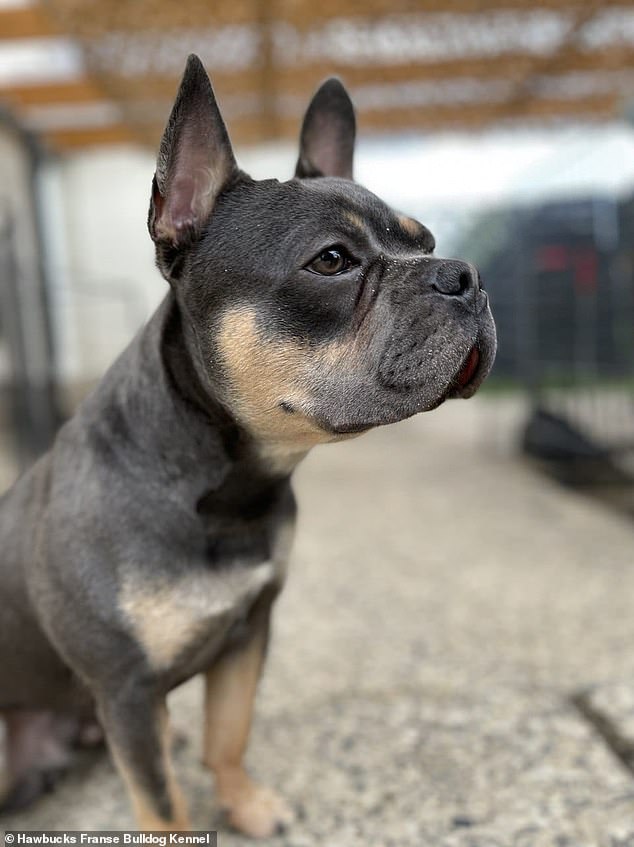
Scientists argue that to make French bulldogs healthy again, they need to have some new genetics brought in from other dog breeds. This individual is part American Staffordshire terrier
Legal options are just one avenue to pursue, though, O’Neill said.
Another huge area is public perception: If members of the general public acknowledge and accept that selective breeding for extreme conformation is hurting dogs, then demand for these purebred dogs will go down.
A major problem, he said, is that people want cute dogs but don’t necessarily recognize that these dogs are suffering under the burden of that cuteness.
When a French bulldog is snorting and wheezing down the street, for example, ‘the general public don’t perceive that that’s the dog suffering,’ he said. ‘So the issue really is our blindness to the suffering.’
But O’Neill and others suspect that there is actually not enough genetic diversity within the Frenchie breeding pool to breed healthier dogs.
To put it another way, long snouts have been so thoroughly bred out of French bulldogs that there aren’t enough individuals with normal-sized snouts to have purebred French bulldog puppies that are innately healthy.
‘A dog that’s innately healthy is a dog that is born with the capacity to do all the natural functions that a dog of its age would be expected to be able to do, like sleep and run and breathe,’ O’Neill said.
As he sees it, that simply is not possible with purebred French bulldogs.
Instead, he said, other genetic material needs to be brought in.
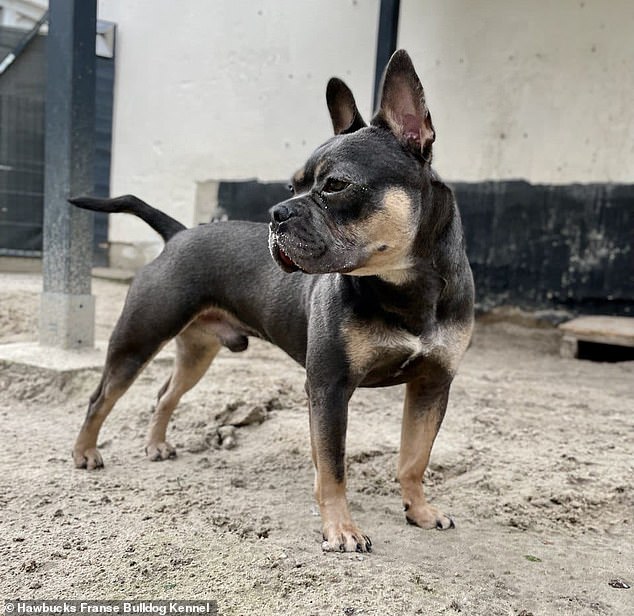
Käpt’n is the third generation of descendants from a French bulldog who was bred with an American Staffordshire terrier
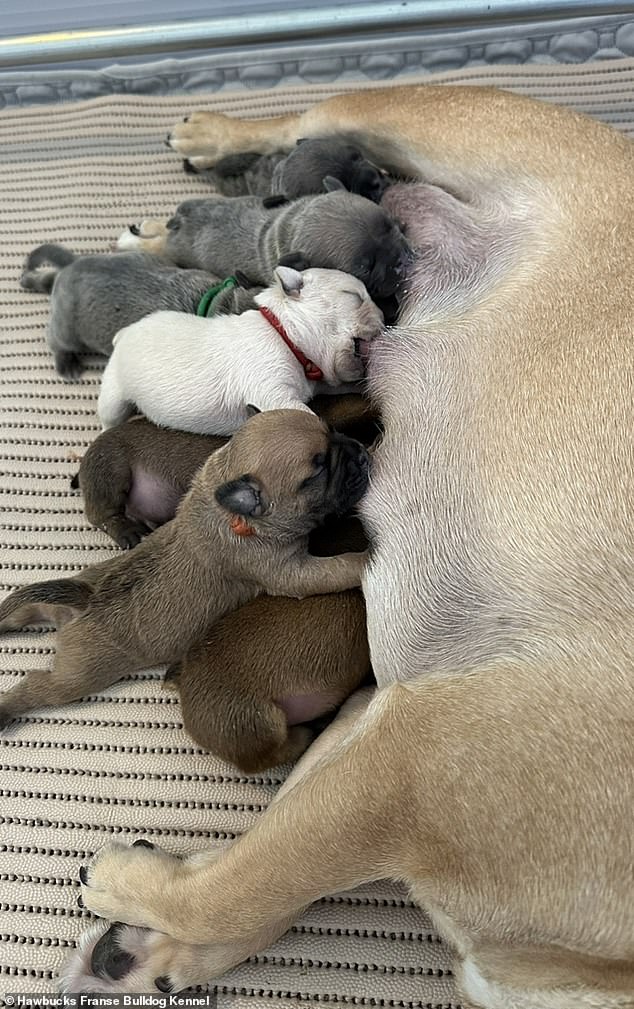
Lily and Käpt’n’s puppies are F4 hybrids, but because they are predominantly French bulldog, they can be considered purebred.
Simply put, to save Frenchies, they must be interbred with other dog breeds who possess healthy traits.
To this end, Lily just had a litter of puppies this month.
And while Lily is purebred French bulldog with more humane dimensions, her puppies take it a step further.
These dogs are technically, genetically French bulldogs. But they also contain something special: another breed’s traits.
Their father is the third generation descendant of a French bulldog bred with an American Staffordshire terrier, making him what’s known as an F3 hybrid, and the puppies F4.
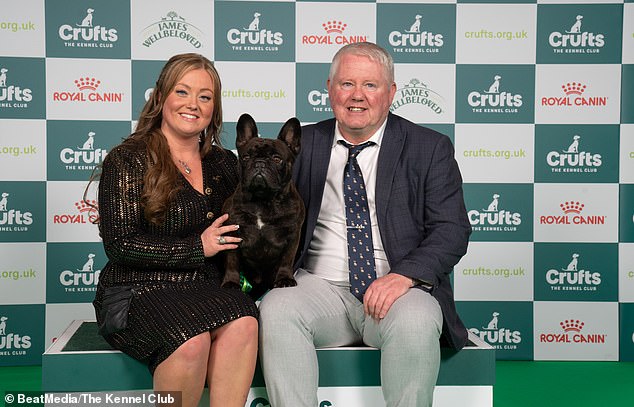
The winning dog Elton scooped the prize for the best canine in the Utility Group and Best of Breed but animal welfare campaigners criticized the judges’ decision

Campaigners were concerned that Elton (pictured) had ‘no discernable nostrils’ and would therefore struggle to breathe but Crufts officials said he had passed all the health checks
Hawbucks French bulldogs from Wageveld-van Kruining’s kennel go for $3,000-3,500, depending on whether they can be homed at nine weeks old or must be kept at her kennel longer before being sent abroad.
‘The highest goals should be happy and truly healthy dogs with longevity, and it does not matter if they have a small percentage of other breeds in them if that is what it takes to accomplish that,’ she said.
O’Neill, for his part, agreed.
Broader progress may be hard-won, however.
Just this month at Crufts – around the same time Lily and Käpt’n had their puppies – a particularly extreme French bulldog won both Best in Breed and Best in Group for the Utility Group.
Named Elton, this Frenchie has ‘no discernible nostrils,’ according to many observers, and a face so flat that it looks concave from certain angles.
O’Neill, like the others, is a lover of animals, and he has nothing against Elton as a dog.
‘The dog itself is lovely,’ he said, ‘but this body is totally extreme.’
And when an individual dog that exhibits such extreme conformation wins the day, it becomes a sort of representative of the breed, showing the public what they should expect a French bulldog to look like.
The signal to would-be dog show winners, too, is clear: To win, your pup should look more like Elton.
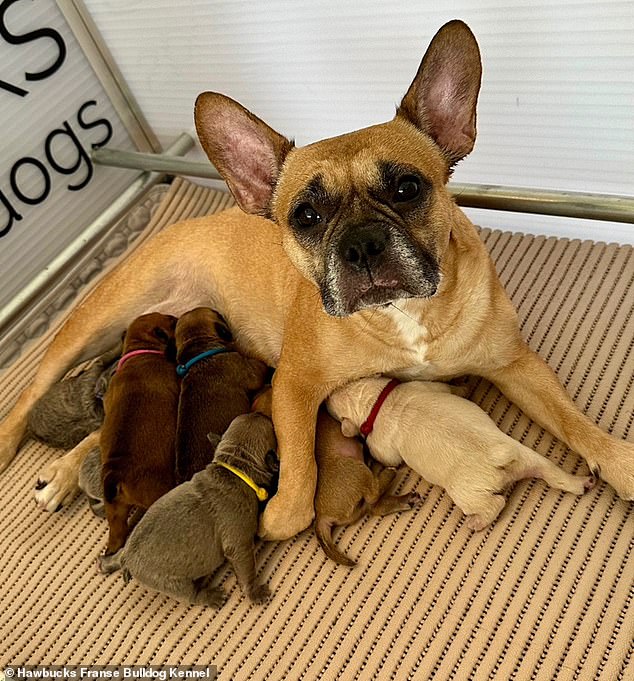
Lily nurses the next generation of Hawbucks French bulldog puppies. These dogs contain American Staffordshire terrier DNA.

This AI-generated series of images offers a look at what French bulldogs could look like with some careful breeding to introduce healthier traits. At far left is what the breed looks like now, with a short nose and short spine and short legs. At far right is what it could look like in just a few generations of careful breeding.
Fortunately, Olstad pointed out, changing people’s minds about dog breeds may actually not be so hard.
He points to the golden doodle as an example of ‘a very expensive mutt’ – a dog that is not purebred but is still highly desirable to dog buyers.
The curly-haired hypoallergenic pup is not a purebred dog, but a mix of the golden retriever and the poodle.
So if this example is anything to go by, people who want a brand-name dog may be ready to accept dogs like the Hawbucks – a French bulldog that looks more like Lily and less like Elton.
The breeder organizations making the rules about purebred dogs may remain an obstacle to change, partly because admitting that the breed needs to change would also be an admission that what they have been doing is harmful to dogs.
But by reaching the general public, people like Olstad, O’Neill and Wageveld-van Kruining hope to change minds.
‘I have noticed the group calling for change gets bigger and bigger,’ Wageveld-van Kruining said. ‘They WANT a healthier dog they can enjoy longer without any worries about them being healthy or happy.’

